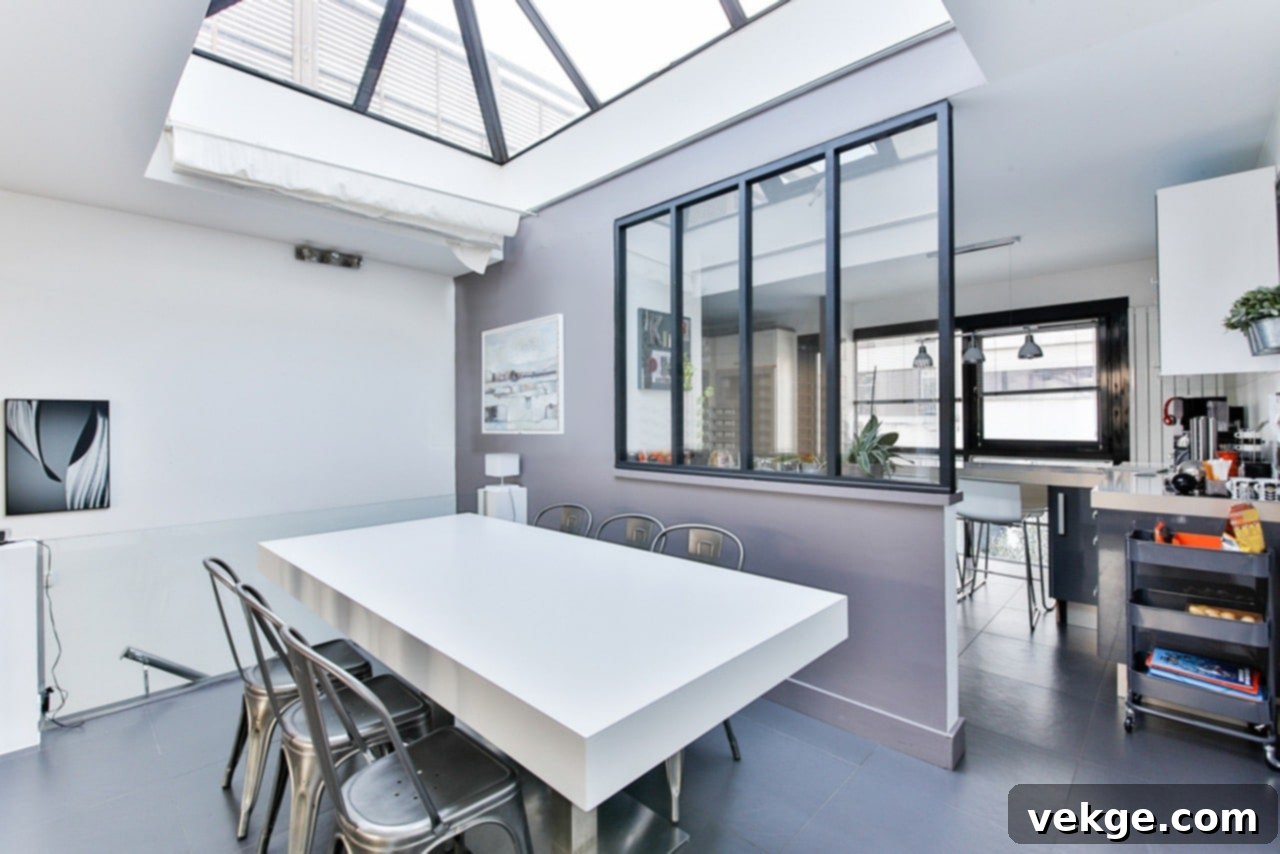Mastering Your Industrial Kitchen’s Color Palette: A Comprehensive Guide to Design Harmony
Your kitchen often serves as the vibrant heart of your home. It’s where culinary magic happens, new recipes are explored, and cherished family moments are created. Given the significant amount of time spent in this central hub, it’s only natural that you would want its design, particularly its color scheme, to perfectly align with your personal preferences and functional needs. The right colors can dramatically transform a space, influencing moods, energy levels, and overall ambiance.
The vast array of choices available today—from endless color swatches to diverse countertop materials, cabinet styles, and overall kitchen aesthetics—can often feel overwhelming. This is especially true when embarking on a renovation project for a unique style like an industrial kitchen, which blends raw utilitarianism with sophisticated design. Finding that ideal balance requires thoughtful consideration of various elements.
To help you navigate this exciting yet challenging journey, this comprehensive guide will show you how to thoughtfully select the perfect color palette for your industrial kitchen. By understanding the nuances of color and design principles, you can confidently choose a palette that brings your dream kitchen to life, creating a space that is both visually stunning and deeply personal.
Crafting the Ideal Color Palette for Industrial Kitchens
When the term “industrial style” comes to mind, initial images might conjure up visions of vast warehouses, exposed structural elements, towering ceilings, and the rugged charm of repurposed factories. Indeed, the industrial aesthetic originated from these raw, utilitarian spaces. However, it has gracefully evolved into a more refined and modern style, making it remarkably adaptable for contemporary homes. Today’s industrial kitchens beautifully blend functionality with character, incorporating elements that range from sleek stainless steel and earthy tones to unexpected pastels and nature-inspired hues. This versatility means you’re no longer limited to just grays and metallics; the style embraces a broader spectrum.
As you embark on selecting a color palette for your industrial-styled kitchen, several crucial factors should guide your decisions. These considerations ensure that your chosen colors not only look fantastic but also contribute to the functionality and atmosphere you desire. Below, we delve into key aspects to keep in mind, helping you create a kitchen that truly reflects your vision.
1. The Pivotal Role of Good Lighting in Your Home
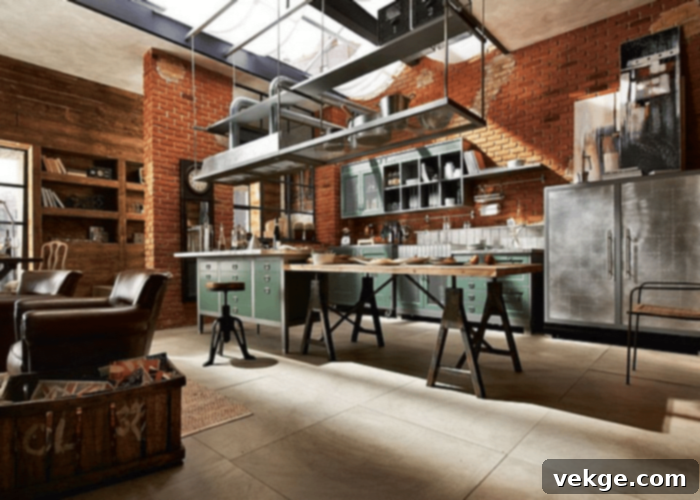
Lighting is an absolutely critical element in how any color is perceived within a room. Both natural and artificial light sources play a significant role in defining the appearance and mood of your chosen palette. While colors often appear most vibrant and true under soft, natural daylight, this ideal scenario isn’t constant in every kitchen throughout the day. The amount and quality of natural light entering your kitchen will fluctuate dramatically from morning to evening, directly impacting how your wall colors, cabinet finishes, and even decor elements look.
To make an informed decision, observe your kitchen throughout the day. Note how much natural light it receives, how shadows play, and how the light changes in intensity and warmth. Additionally, consider the type and amount of artificial lighting you plan to incorporate. Are you opting for warm, inviting Edison bulbs characteristic of industrial design, or bright, cool LED task lighting? Warm lights can make colors appear richer and cozier, while cooler lights might lend a crisper, more modern feel. Understanding these lighting dynamics is essential for selecting a color that consistently pleases the eye, regardless of the time of day.
2. The Importance of Testing Kitchen Colors Before Committing
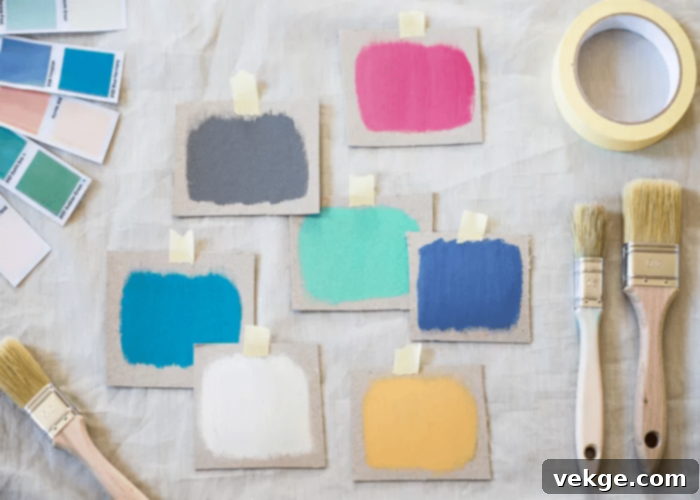
As highlighted, the appearance of colors is highly dependent on ambient lighting conditions. What might look appealing in a paint can or on a small swatch in a brightly lit store can appear drastically different on a large wall in your kitchen. This phenomenon, known as metamerism, underscores why thorough testing is absolutely crucial before you make a significant investment in paint for your industrial kitchen. The cost and effort of repainting due to a color misjudgment can be substantial, making this step invaluable.
To avoid costly mistakes, always purchase sample pots of your preferred paint colors. Apply generous swatches of these samples directly onto your kitchen walls, ideally on different walls to observe them under varying light. It’s highly beneficial to test several colors simultaneously, allowing you to compare them side-by-side. Observe these painted sections at various times of the day—morning, midday, and evening—and under both natural and artificial light. This comprehensive approach will reveal how each color interacts with your kitchen’s unique environment, ensuring your final choice is one you’ll truly love for years to come.
3. Harmonizing with Your Home’s Overall Color Scheme
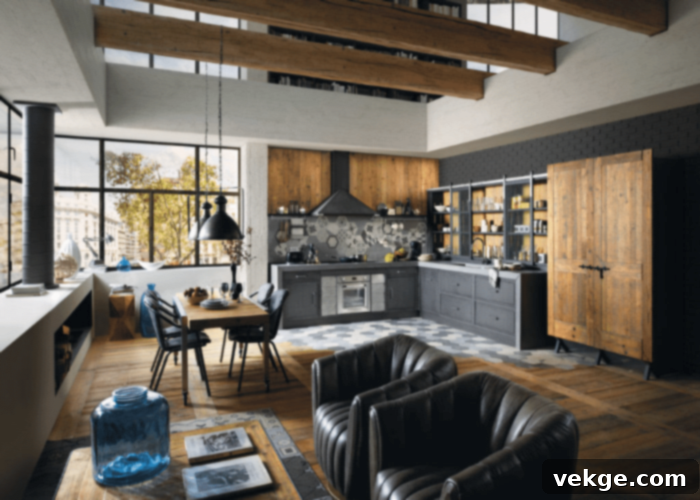
A well-designed home boasts a seamless flow of aesthetics from one room to the next. When conceptualizing the color palette for your industrial kitchen, it’s vital to consider its relationship with the broader color scheme of your entire house. Think of your home as a single, cohesive narrative where each room is a chapter. A jarring color transition, such as an intensely orange kitchen abruptly leading into a cool blue dining room, can disrupt this narrative and create a sense of disconnect.
Pay close attention to adjacent rooms and how colors transition between them, especially in open-plan living spaces where the visual connection is immediate. Your kitchen’s palette should complement or subtly contrast with neighboring areas, creating an inviting and unified atmosphere. This doesn’t mean every room must share the exact same colors, but rather that the chosen hues should belong to a harmonious family or employ a thoughtful progression. A coherent color scheme throughout your home enhances its overall appeal, making it feel more integrated, sophisticated, and ultimately, more welcoming.
4. Prioritizing Your Personal Color Preferences

While expert advice and current trends offer valuable guidance, this fundamental rule remains paramount: this is your home, and your kitchen should be a reflection of your unique taste and style. The colors and designs you choose are deeply personal decisions that contribute to the overall feeling and character of your living space. What one person perceives as an overly bright or stimulating color, another might find incredibly soothing or energizing. Everyone possesses a distinct palette of preferences, and it’s these individual inclinations that should ultimately steer your choices.
Don’t get too caught up in fleeting design trends or what’s currently popular. Instead, focus on colors that genuinely resonate with you and evoke positive emotions. After all, you will be the one spending countless hours cooking, entertaining, and simply enjoying your kitchen. Select colors that make you feel happy, comfortable, and inspired. Your kitchen should be a sanctuary where your personal aesthetic thrives, making every moment spent there a true pleasure.
5. Embracing the Power of Bold Colors
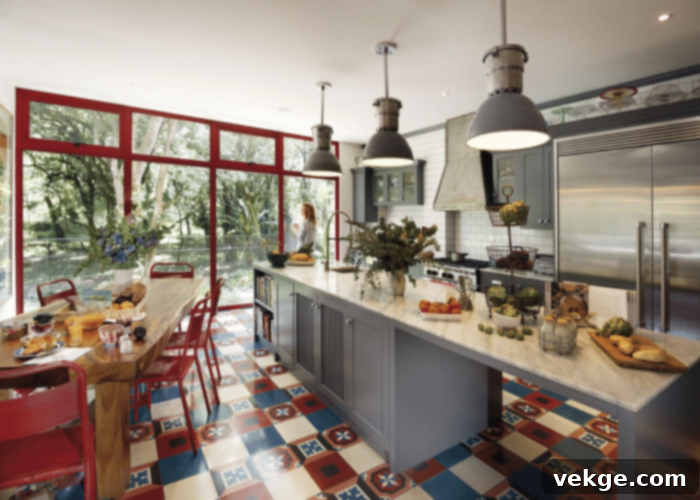
While some homeowners shy away from vibrant hues, fearing they might overpower a space, bold colors can be incredibly effective when used thoughtfully, particularly in an industrial kitchen setting. Unlike a large bedroom, which offers expansive walls as a canvas, kitchens often have less continuous wall space due to the presence of cabinets, backsplashes, and prominent kitchen hoods. This unique architectural structure actually makes kitchens an ideal environment for incorporating bold shades.
Instead of dominating the entire room, a bold paint color in a kitchen can function more like a strategic accent or a vibrant “color pop.” Imagine a deep emerald green backsplash against a backdrop of raw brick, or a striking crimson accent wall peeking out between sleek metal cabinetry. These bold choices can highlight specific architectural features, draw attention to key elements like a vintage range, or simply inject personality and dynamic energy into the otherwise often neutral tones of industrial design. When paired with the characteristic textures and materials of an industrial kitchen—think exposed brick, concrete, stainless steel, and reclaimed wood—bold colors create a sophisticated contrast that is both modern and memorable, enhancing the overall aesthetic without overwhelming it.
6. Exploring the Serenity of a Minimally Styled Industrial Kitchen
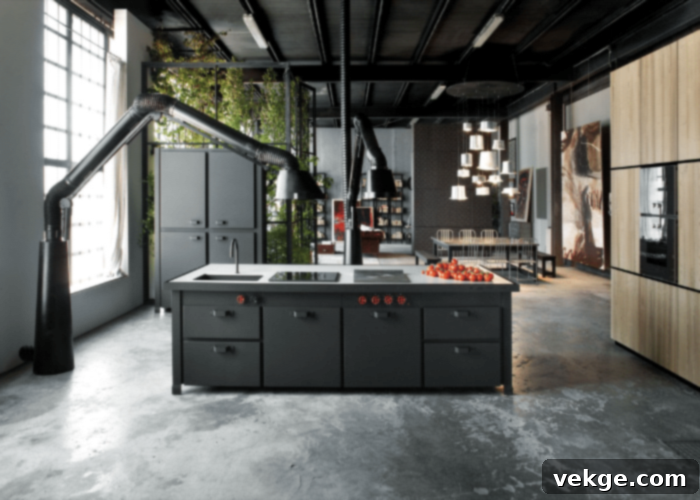
The process of decorating your home is a truly joyful endeavor, offering a plethora of options in colors, textures, and styles for interior design. Among these, minimalism stands out as an exceptionally compelling choice, especially for the inherent clean lines and functional focus of an industrial kitchen. If your inclination is towards a less cluttered and more serene environment, embracing a minimalist aesthetic for your kitchen is an excellent path.
Minimalism is fundamentally characterized by creating uncluttered, simple, and highly functional spaces. In an industrial kitchen, this can translate into sleek, handleless cabinetry, streamlined stainless steel appliances, and a focus on essential elements. A monochromatic color palette, relying on variations of a single color or a limited range of complementary neutrals like grays, whites, and blacks, can be just as striking and beautiful as a bright, multi-colored scheme. This approach highlights textures and materials—the raw beauty of concrete, the gleam of metal, the warmth of wood—rather than relying on bold color to make a statement. Given that your kitchen is often a bustling hub of activity, a minimalist design can significantly reduce visual noise, promoting a sense of calm and order. It allows for effortless organization and maintenance, ensuring your kitchen remains a functional, tranquil, and timeless space free from unnecessary distractions.
Final Thoughts on Designing Your Industrial Kitchen’s Palette
Achieving a kitchen design that perfectly aligns with your vision is truly a dream come true. Every element, from the style and finish of your cabinets and countertops to the choice of kitchen equipment and, most crucially, the color scheme, plays a pivotal role in crafting a space that is both functional and aesthetically pleasing. The world of interior design is constantly evolving, offering a wealth of guidelines and inspiration to help you discover exactly what you desire for your home.
This guide has provided you with essential insights into deciding on the ideal color palette for your industrial kitchen. By carefully considering lighting, testing colors, harmonizing with your home’s overall scheme, honoring personal preferences, embracing bold accents, or opting for minimalist serenity, you can create a kitchen that is not just a place for preparing meals, but a true extension of your style. The right kitchen environment can transform daily routines, making the process of cooking your favorite foods even more enjoyable and delicious, elevating it from a chore to a cherished experience.
We’d love to hear from you! Please share in the comments below which color palette you ultimately selected for your industrial-styled kitchen, what factors influenced your choice, and any other important details or tips you think would be beneficial for others embarking on their own kitchen color palette journey.
